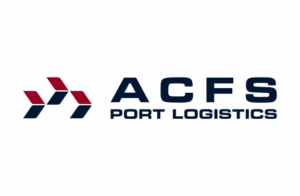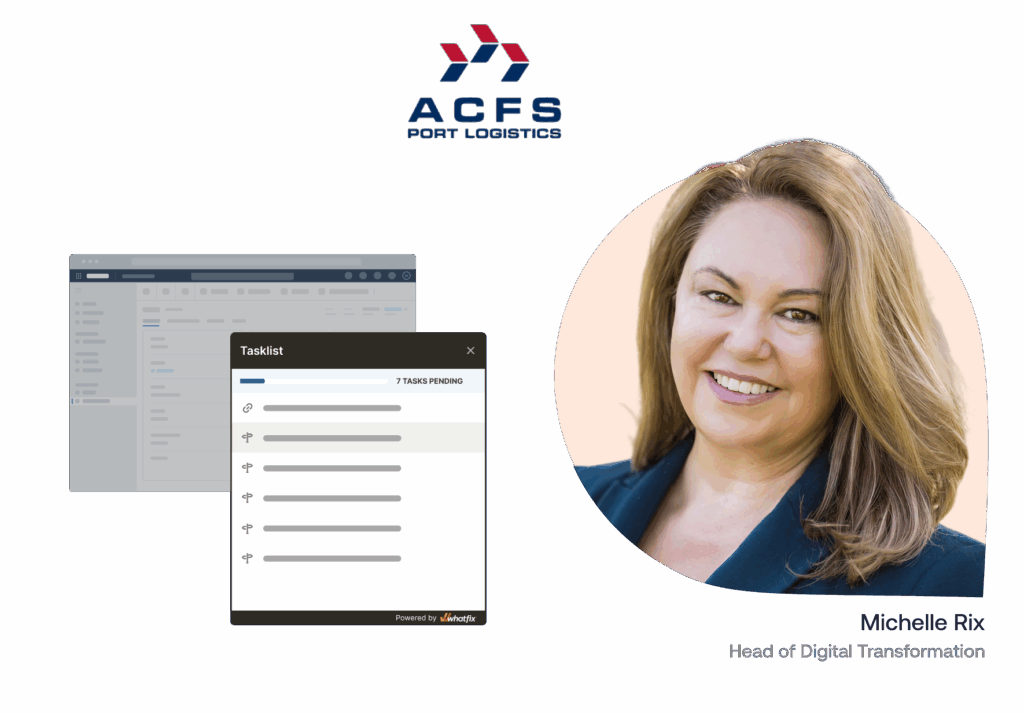
ACFS Port Logistics Streamlined User Testing & Training With Whatfix—Saving $1.1M
ACFS Port Logistics transformed its new transportation management system (TMS) rollout by simplifying user acceptance testing (UAT), embedding feedback loops, and enabling change agents in the flow of work with hands-on user training, proving that transformation success starts with great enablement.

The Whatfix Difference


The ACFS Port Logistics Story
Bridging Port to Platform: ACFS’s Transportation Management System Transformation
ACFS Port Logistics is Australia’s largest privately owned container logistics company, operating across all major ports and servicing over 850,000 TEUs annually. The company offers a full spectrum of services—transportation, intermodal rail, warehousing, and customs—and is a vital link between port terminals and inland destinations across retail, FMCG, and industrial sectors.
To future-proof operations and improve customer experience, ACFS made the bold move to migrate to a new transportation management system (TMS) with new capabilities and advanced features. A shift of this magnitude required more than technology; it required new ways of working. ACFS needed to ensure teams were engaged early, workflows were validated before go-live, and users felt confident using the new platform from day one.
“Whatfix has enabled an organization that is just embarking on their digital journey to understand the technology, remove the fear, and guide our teams through systems in a way that feels familiar,” said Rix, Head of Digital Transformation at ACFS.
The Challenge
Taking the Fear Out of User Acceptance Testing and Change Management
Most ACFS employees had minimal experience with enterprise software tools and their workflows, and the company lacked the internal bandwidth for high-touch training, user acceptance testing (UAT), and performance support.
UAT was critical, but time-consuming. Manual test documentation, duplicate onboarding efforts, and scattered support resources slowed progress, delayed feedback loops, and increased costs. With multiple time zones, shift-based work, and limited training resources, rolling out consistent and repeatable UAT across Australia was a massive challenge.
ACFS had onboarded a centralized SME UAT team, but later moved to a decentralized model, putting additional strain on the training team. Major bottlenecks included:
- Limited capacity to coordinate live UAT sessions, with a disjointed feedback collection process.
- Duplication of the same issues by multiple users in Jira.
- Difficulty identifying disengaged or struggling subject matter experts (SME).
- UX issues surfaced too late—often during in-person training.
ACFS needed a better way to train SME change agents, simplify testing, and streamline feedback—all while tracking UAT effectiveness and adoption in real time.
“New technology is exciting, but it rarely comes with a user manual. Even if I had the budget for five trainers, a digital adoption platform would still be necessary to deliver consistent messaging, clear workflows, and accessible resources, making adoption smoother and less stressful,” said Rix.
The Solution
From Tasks to Tickets: Embedding Feedback Into the Workflow
ACFS reimagined its UAT process by deploying Whatfix to onboard SME change agents into each UAT iteration and embedded all testing, learning, and feedback within the new TMS interface.
Here’s how it worked:
- When SMEs logged into the UAT environment, a Whatfix-powered Task List appeared.
- Each task included a video walkthrough of the functionality being tested.
- SMEs followed step-by-step Flows to complete tasks, including exception handling.
- If they encountered a bug, had a question, or spotted an improvement, they clicked a built-in link to raise a Jira ticket directly from the interface.
- Finally, SMEs were tasked with completing the workflow independently.

“The Whatfix team worked closely with us to build in functionality ensuring the system was fit for our new purpose,” Susan Nguyen Huynh, Systems Analyst.
Integrating with Jira, each logged ticket was automatically routed to the right board, captured all mandatory fields (like steps to reproduce the issue and screenshots), linked to the relevant TMS epic, and automatically sent status updates to the reporter.
“We show users a video, walk them through it step-by-step, and have them try it themselves. What we’re finding now is that people aren’t even noticing Whatfix—it’s just part of their experience,” said Rix.
With Whatfix Product Analytics, ACFS was able to identify additional areas of user friction, such as tasks where users spent too much time or became disengaged.
„Using Whatfix Analytics, we can support users from day one—even if they have no prior knowledge—guiding them to confidently navigate the system and complete their tasks. The insights we gain also allow us to spot trends and make informed decisions to continuously improve our TMS experience,“ said Rix.
The Results
Fewer Trainers, Localized System Specialists, and Higher User Engagement, All Driving Change Outcomes
Whatfix helped ACFS streamline UAT, reduce training time, and increase TMS user engagement in just a few months. The impact was felt across the transformation efforts, from validating and testing its new user workflows before launch to supporting users in the flow of work with embedded guidance.
„Even with a budget of 40 trainings to accommodate 30+ sites with 24-hour shifts, utilizing Whatfix has enabled the use of AI for content creation, standardize our in-app messaging, and help users learn at their own pace,“ said Huynh.
ACFS’s new approach to UAT paid off in measurable ways, like time savings and post-transformation user confidence. This included 1,325 hours saved in phase one of its TMS implementation, including:
- 174 hours were saved by the Delivery team during training.
- 1,073 hours saved by SMEs during testing.
- 77.3 hours saved by the development team via Jira automation.
In phase 2 of its implementation, ACFS saved another 2,938 hours across user testing, training, and development work. It was able to attribute direct business impact from its Whatfix investment, including:
- 4,263 total hours and $64,573 saved in UAT and training efforts in phases 1 and 2 of its implementation and launch.
- $1,120,000 saved by streamlining user training and workflow testing.
- Reduced SME onboarding time.
- Enabled asynchronous testing across shifts and time zones.
- Empowered product owners and system analysts with real-time analytics.
- Improved UAT documentation and audit readiness.
- Created repeatable, video-led training for future rollouts.
- Faster internal approvals and digitized test scripts.
„Whatfix empowers all of our staff to learn at their own pace, building confidence and capability. We now have a calm, highly engaged team – something that doesn’t come easily,” said Rix.
Looking ahead, ACFS plans to integrate Whatfix Product Analytics with Power BI to segment users, measure behaviors, and drive data-led adoption. They’re also exploring Whatfix AI to bring more automation and contextual personalization to the in-app experience.
“The Whatfix team has been extraordinarily collaborative,” said Huynh. “They’ve helped us use DAP differently—and allowed us to create an in-app experience unique to ACFS.”

Industry: Logistics
Use Case:
- User Testing
- User Onboarding
Application For: Transporation Management System (TMS)
User Type: Service-facing teams
Read more customer stories
See how other brands empower their customers, employees, and end-users with Whatfix’s in-app guidance and support.
FAQs
Don’t see your answer? Send a message to our live chat, we’d be happy to help!
What is a digital adoption platform?
A digital adoption platform (DAP) overlays onto other software applications that provide in-app guidance and on-demand support to users. Admins use no-code editors to create, publish, and manage in-app content such as product tours, interactive walkthroughs, smart tips, task lists, and self-help wikis that help assist and guide users through applications in real-time.
Can I sign up for a free Whatfix trial?
Absolutely! You can sign up for a free trial to give Whatfix a test drive here.
What is Whatfix's pricing?
For full pricing information, please visit out pricing page.
Pricing for each product and plan is composed of a flat fee, plus user license fees. The flat fee depends on the product and plan you need. User license fees are defined based on the type of user who will access the application where Whatfix will be deployed, as further defined below:
For employee-facing applications used by your employees for internal business functions a user license is equal to the total number of users with access to such application.
For customer-facing applications used by your customers or external-facing users (partners or any other third-party) a user license is equal to the monthly active users (MAUs) with access to such applications.
How does Whatfix compare to its competitors?
What is the largest pure-play digital adoption vendor in the marketing. Explore our Compare Hub to see why Whatfix is the DAP market leader.
What type of applications does Whatfix support?
Whatfix supports both web-based, mobile, and desktop (or on-premise) implementations – as well as internal use cases for employees and external use cases for customers.
For our web-based cloud offering, you just need to install our Whatfix Editor extension on Chrome or Firefox, and you are ready to get started. Our editor’s user experience is so simple that you can create interactive guides easily, with no technical dependencies or setup required.
Our mobile DAP deployment utilizes an SDK.
We also offer full support for on-premise setups. Our on-premises export version allows you to export and deploy Whatfix guides on your own web server.
How can I read Whatfix reviews?
You can find Whatfix DAP on all major software review websites including G2, Capterra, SoftwareAdvice, Gartner, TrustRadius, etc. We recommend starting with Whatfix reviews on G2.com, as it is the largest, most established third-party review network. With 350+ reviews, Whatfix has been named a Leader in the DAP category for 9 consecutive reports.
What types of companies work with you?
Our customers range from SMBs, large enterprises, and Fortune 100 companies across verticals, including:
- SaaS companies
- eCommerce marketplaces
- Insurance companies
- Healthcare providers
- Media companies
- Governments
- Universities
…and many more – all solving their digital adoption challenges by empowering their employees, customers, and end-users with Whatfix.
What is the difference between Guidance Analytics and Product Analytics?
Whatfix offers two types of user analytics: Guidance Analytics and Product Analytics.
Guidance Analytics is included for all Whatfix DAP customers. It provides engagement and usage data on your in-app content built with Whatfix. See Task List completion rates, Flow dropoffs, Smart Tip views, common Self Help queries, and more.
Whatfix Product Analytics is a comprehensive no-code event-tracking solution. It empowers application owners and product managers to analyze user behavior on internal software and customer-facing apps.
What is Whatfix Mirror?
Whatfix Mirror is an application simulation software builder that provides interactive, replica sandbox environments of any web application for hands-on end-user training.
Quickly create interactive, replica versions of any web application to provide end-users with a sandbox environment for hands-on software training or user testing, without risking live software usage.
See why Fortune 1000 enterprises and growth companies choose Whatfix as their digital adoption and user experience partner.


